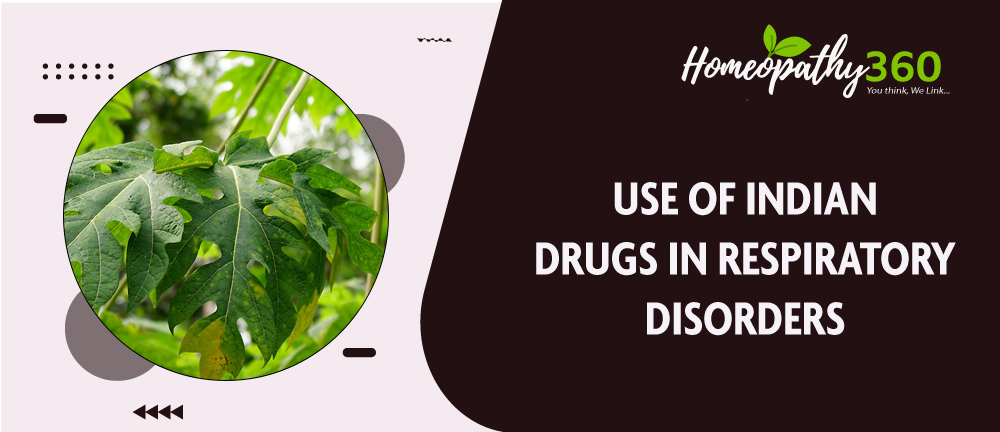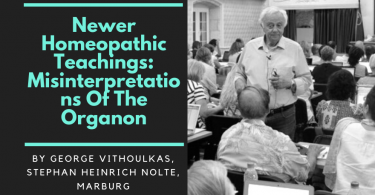
ABSTRACT
India is a country blessed with a treasure of medicinal plants and herbs. The use of indigenous drugs in homoeopathic practice is quite memorable. Such drugs are valuable remedies, which are useful both in acute and chronic diseases. They have also been found to possess great therapeutic virtues at the time of emergency. This article presents some of the important indigenous drugs of India having clinical use in the treatment of certain common acute and chronic respiratory problems.
KEYWORDS
Homoeopathy, indigenous drugs, respiratory disorders.
ABBREVIATIONS
quality of life (QOL), before christ (B.C.)
INTRODUCTION
India, the vast and fertile country, is a veritable encyclopedia of the vegetable world.The science of life is believed to be as old as the vedas themselves. The mention of the medicinal use of herbs and plants has been made in the rig veda, which has been written between 4800 B.C. and 1600 B.C.There are many herbs and plants in India whose therapeutic virtues and identities are sufficiently known. Many homoeopathic medicines are now being prepared from indigenous plants and herbs of India. Their efficacy in acute and chronic cases have been acknowledged and experienced by all.[1]
It is a fact that homoeopathy has now spread its wings over all the cities and remote villages in India.[1]The beauty of homoeopathy is its materia medica, which portrays the most reliable picture of a medicine in its true perspective.[1]The Homoeopathic Pharmacopoeia of India is rich with the monographs of Indian drugs.
Respiratory diseases account for 4% of the global and 8.3% of the overall burden of chronic disease, having a major adverse impact on sufferers quality of life (QOL),disability and productivity and resulting in increased economic burden for both the individual and community.[2] Homoeopathic drugs are capable of removing these burdens, effectively without any adverse reactions. The homoeopathic materia medica books are rich with so many Indian drugs which are useful for different respiratory disorders. In this article, some Indian drugs which are frequently used by the physicians for various respiratory diseases are discussed.
1.Acalypha indica[3,4]
Common name–Indra maris
Symptomatology :
•Violent, dry, teasing cough, <in morning and at night, followed by spitting of blood.
•Lung diseases having characteristic haemoptysis of fresh blood in morning, followed by dark and clotted in afternoon.
•Rattling sounds in the throat.
•Dry cough, >drinking cold water with burning sensation over face and dryness of mouth.
2.Acorus calamus[3]
Common name–Sweet flag
Symptomatology :
•Phlegmatic condition of lungs from damp, cold; promotes expectoration, resolves phlegm, promotes astriction and stops discharge.
•Cough with thin, white sputum; chest pain and chills,>by vomiting.
•Chronic bronchitis.
3.Allium sativum[3,4]
Common name–Garlic, Losohn
Symptomatology:
•Sensitive to cold air, difficult respiration as if the sternum is compressed.
•Painful irritation of the larynx and trachea when coughing. Pain, rawness, and scraping sensation in the larynx excites dry cough; almost continuous mucus rales in bronchi.
•Cough seems to come from the stomach and gives rise to a perceptible foetid smell.
•Cough in the morning after leaving the bedroom with extremely copious mucus expectoration; dilated bronchi.
•Sudden paroxysms of hard, dry cough while smoking, compelling him to desist.
4.Arctium lappa[3]
Common name–Great burdock, cheron
Symptomatology:
•Sharp, choking cough as from larynx. Breath short, oppressed at 10.00p.m. with heat.
•Tickling sensation in glottis with cough having loose sounds, but no expectoration.
•Acute tingling, cutting pain under the middle of the sternum, extending across the breast; shortness of breath on exertion.
•Irritation in bronchi with cough.
•Bronchial asthma.
5.Azadirachta indica[1,3,4]
Common name–Neem
Symptomatology:
•Very troublesome cough, < after bathing.
•Sputa white, in small lumps,expelled with great difficulty.
•Short,dry cough in the afternoon, sputa white and tasteless.
•Cough with greyish expectoration, slight hoarseness.
•Sighing and deep breathing at long intervals, breathing very rapidly and hot.
6.Boerhaavia diffusa[1,3,4]
Common name–Punarnava
Symptomatology:
•Cough with thick white, scanty expectoration,<at night.
•Dry cough,< at night, cold air, waking in morning.
>by rest, warm drinks, supporting chest with hands.
•Asthmatic dyspnoea. Rattling cough with pain in the chest.
•Coryza with a dry cough.
•Cough with thick, white, mucoid expectoration.
•Shortness of breath,<on empty stomach, after meals, walking a little. Unproductive cough.
7.Calotropis gigantea[1,3,4]
Common name–Akanda
Symptomatology:
•Sense of oppression in chest, shortness of breath.
•Frequent cough,<in morning with sneezing,> during day time.
•Cough with scanty, thick greyish expectoration,<in morning while rising from bed,>by warm application, warm drinks.
•Dry cough, fever, body ache and sneezing.
8.Cassia sophera[3]
Common name–Kalkasunda.
Symptomatology:
•Cough,<lying on right side,asthmatic with allergic eruptions,<mid-night.
•Unproductive asthma with constipation, cough,<from dust, smoke and in winter.
•Dry cough with irritation (tickling sensation in throat),stitching pain in the lower chest, diminished(or lack of)appetite, increased thirst for cold water, must drink every hour.<walking coughing,>lying down, hot drinks.
9. Cinnamomum zeylanicum[3]
Common name–Dalchini
Symptomatology:
•Oppressed breathing, with vertigo and weakness.
•Head severely affected, with oppression of chest and hysteria.
•Rheumatic catarrh.Hoarseness with cough.
•It clears the voice when muffled by secretions, scatters the phlegm, and is useful in cases of tickling in the larynx.
10. Ficus religious[1,3,4]
Common name–Ashwatho.
Symptomatology:
•Difficulty in breathing, sense of oppression.
•Cough with expectoration, blood streaked mucus or spitting of blood, preceded by nausea.
•Dry cough of long duration,<in morning, evening, while speaking,>after drinking cold water.
•Cough with thin expectoration, white and loose.
•Patient is very weak and restless.
11. Hydrocotyle asiatica[3,4]
Common name–Brahma manduki,Thalkudi.
Symptomatology:
•Pricking sensation in the vicinity of glottis.
•Dryness of larynx.
•Voice weak,speaking soon fatigues. Irritation of air passages.
•Respiration difficulty, gasping.
•Cough with tickling sensation in throat and substernal pain while coughing; redness of face with hoarseness of voice.<in daytime, open air,after sleep,>by sitting, drinking water.
•Cough with constriction of trachea and tightness in chest,irritation and pain in throat.
12.Justicia adhatoda[4]
Common name–Vasaka.
Symptomatology:
•Highly efficacious in cold, coryza, cough, bronchitis, pneumonia, phthisis and haemoptysis.
•Audible rattling of mucus in the chest, difficult expectoration, loosened only by repeated hawking. Expectoration of tough, yellow mucus.
•Dry spasmodic cough, sense of constriction, dyspnoea associated with cough,threatened suffocation.
•Whooping cough, child loses breath, turns pale,becomes still and blue; rigid body.
•Vomiting with a cough,no food or drink is retained in the stomach.
•First stage of phthisis,haemoptysis.
•Hoarseness, larynx painful to touch.
•Tightness across the chest, asthmatic attacks, can’t endure a close warm room, coughing with wheezing.
13.Leucas aspera[3,4]
Common name–Drona,chota halkusa.
Symptomatology:
•Infantile respiratory distress.
•Newborn baby unable to breastfeed due to cold.
•Rattling sounds in chest.
•Nasal catarrh, nose full of discharge with heaviness of chest.
•Bronchial asthma.
14.Ocimum sanctum[3,4]
Common name–Tulasi,Kala tulasi
Symptomatology:
•Pain on both sides of chest,<while coughing or sneezing.
•Cough is croupy, early in the morning;dry, hacking in the evening.
•Beneficial in diarrhoea and fever,associated with cold,cough, bronchitis; eases difficult respiration.
•In case of asthma, where the patient sits bending forward and supports head with hands while the elbows rest on the knees; can’t lie quietly in bed.
•Wheezing and rattling. Pain in the middle of the sternum, pleuritic pains.
15.Opuntia vulgaris[3]
Common name–Indian fig,Nagphani.
Symptomatology:
•Heaving respiration, which does not >oppression in the chest.
•Cold shudders right through chest.
•Much mucus rises from the throat, feels sore in the afternoon, and is choked or pinching feeling around the top of the larynx, shuddering on swallowing.
16.Piper nigrum[3,4]
Common name–Black pepper, Golmorich.
Symptomatology:
•Ulceration and false membrane formation, deep in the larynx.
•Voice low,deep,rough, hoarseness with coughing and constant sniffing.
•Dyspnoea with pain in chest in spots;while coughing ,feels as if spitting blood.
•Attacks of suffocation. Severe coughing especially in the evening and on going to sleep.
•Cough is violent, occasionally spitting of blood, croupy,hollow;at each coughing spell,it seems as if chest would be torn and he would spit blood.
•Painful spots on chest,<on coughing.
•Burning,lancinating pains, sensation of heat and dryness of the chest.
•Cough of gastric origin.
•Cough,>after vomiting, drinking water.
17.Polygonum punctatum[3]
Common name–American water pepper, biting knot.
Symptomatology:
•Stifling sensation in larynx, irritability of whole respiratory system.
•Constriction, crowding and pressure about larynx with irritation of bronchi.
•Roughness as of adhesion of mucus to larynx; spasmodic, hacking and hoarseness.
•Hacking cough, worse from change of temperature.
•Dry cough at night, excited by tickling, pricking and tingling in the upper part of the chest,behind the sternum.
•Dry sensation in the larynx when coughing.
•Contracted feeling in throat after swallowing, followed by thirst.
18.Sinapis nigra[3,4]
Common name–Black mustard.
Symptomatology:
•Hoarseness of voice in the evening.
•Cough short, hacking, all evening, seldom during day.
•Cough mostly dry or with expectoration of lumps of mucus,< in cold air,> by lying down and by eating.
•Cough excited by laughing.
•Expectoration from posterior nares, much mucus which felt cold; white tenacious mucous.
•Asphyxia, respiration at the base of right lung roughened.
•Loud coughing spells with barking expiration.
19•Solanum nigrum[3,4]
Common name–Black nightshade.
Symptomatology:
•Respiration rapid, difficult, quick or easy, stertorous.
•Constrictive feeling in chest with difficult breathing, cough with tickling in throat, expectoration thick and yellow.
•Pain in left side of chest, sore to touch.
•Stitches in the throat shooting through the tympanic membrane of right ear.Cramps in the oesophagus.
20.Solanum xanthocarpum[4]
Common name–Kantikari.
Symptomatology:
•An excellent remedy for hoarseness with cough.
•Respiratory disease with aphonia.
•Hoarseness due to any cause with cough, bronchitis, pneumonia and broncho-pneumonia, associated with aphonia.
•A sovereign remedy in asthma.
21.Solidago virgaurea[3,4]
Common name–Woundwort, European golden rod.
Symptomatology:
•Bronchitis, cough with muco-purulent expectoration, blood streaked.
•Continuous dyspnoea, oppressed breathing, asthma with dysuria at night.
•Heavy expectoration on coughing, chronic catarrh of the lungs; croup with little blotches on hands accompanied with diminished urine.
•Naso-pharyngeal catarrh with burning sensation in the throat.
•Flat ulcers in throat.
22.Stellaria media[3]
Common name-Chickweed.
Symptomatology:
•Short cough from tickling on upper chest,< deep inspiration.
•Hawking of viscid, salty mucus.
•Dry unproductive cough, blood streaked sputum.
•Pulmonary tuberculosis,whooping cough,haemoptysis,bronchitis;hard dry cough with scanty, sticky sputum.
•Numbness and dryness in throat, followed later by sharp stitches in left tonsil.
23.Taxus baccata[3]
Common name–Yew.
Symptomatology:
•Violent and fatiguing cough, short cough after every meal, excited by full inspiration with oppression.
•Lungs engorged.
•Oppression when the stomach is either too full or too empty or else with pain below xiphoid cartilage.
24.Terminalia arjuna[1,3,4]
Common name–Arjuna,white murdah.
Symptomatology:
•Dry cough with pain in chest while coughing. Cough with rattling sounds in chest,> warm drinks.
•Expectoration is profuse, greenish and sweetish in taste.
•Sore throat with painful hoarseness of voice.
25.Terminalia chebula[3,4]
Common name–Haritaki,Indian gall nut.
Symptomatology:
•Dyspnoea,< on exertion, motion, jumping, exercise with general weakness. Hot deep breathing.
•Cough with difficult expectoration, dry, paroxysmal, followed by vomiting,>by drinking water, lying down.
•Pain and soreness in throat, with dry cough and scanty, white expectoration and pain in whole body.
•Deep breathing.
26.Tinospora cordifolia[3,4]
Common name–Gulancha.
Symptomatology:
•Severe cough and cold with mild fever. Dry cough in morning and evening.
•Cough with watery, viscid expectoration. Cough,< morning, talking, lying down.> taking hot drinks.
•Loss of voice with pain in throat. Voice hoarse. Sensation of lump in throat in morning along with cough.
27.Tylophora indica[3]
Common name–Emetic swallow-wort, Indian Ipecacuanha.
Symptomatology:
•Pain in throat with cough,<while talking, empty swallowing, from cold drinks,at night.
> by hot drinks and hot food.
•Cough,> by rubbing the chest gently.
•Constriction and pain in chest with dyspnoea.
28.Urtica urens[3]
Common name–Dwarf battle.
Symptomatology:
•Whooping cough, little, frothy expectoration.
•Haemoptysis from least exertion of lungs.
•Bronchitis, asthma, with mucoid expectoration.
•Sore feeling as from a blow in left side of chest.
•Intermittent soreness in right chest during day.
29.Viola odorata[3,4]
Common name–Blue violet.
Symptomatology:
•Torpor at the end of nose,as if from a blow.
•Hoarseness, followed by coryza;dyspnoea with violent cough.< in the daytime.
•Cough chiefly by the day,in long lasting spells, dry, short, violent cough, with much dyspnoea.
•Whooping cough in nervous, thin little girls. Respiration difficult and scarcely perceptible, with painful expiration, excessive anguish and violent palpitations.
•Shortness of breath, sputum profuse, clear,ropy,jelly-like.
•Difficult respiration during pregnancy.
30.Viscum album[3,4]
Common name–Mistletoe.
Symptomatology:
•Respiration asthmatic, difficult, with cough. Cough barking, painful, spastic,< on lying down,> in open air.
•Expectoration of grey,glairy mucus, tough,yellow. Bronchi inflamed.
•Spasm of glottis with dry sensation in throat.
•Complete block causing efforts to swallow and eyes to fill with tears.Breathing slow and stertorous.
•Dyspnoea,feeling of suffocation when lying on left side; asthma if associated with gout or rheumatism.
CONCLUSION
Thus, the above discussed Indian drugs prove to be of clinical use in the treatment of certain common acute and chronic respiratory problems.
REFERENCES
1.Ghose SC. Drugs of Hindoosthan with their homoeopathic uses,proving & clinical verification. 9th ed. Calcutta: Hahnemann Publishing co.;1998.
2. World Health Organization. Global surveillance, Prevention and Control of Chronic Respiratory Diseases: A Comprehensive Report. Geneva: World Health Organization; 2007.
3. Central Council for Research in Homoeopathy.Homoeopathic Materia Medica of Indian Drugs.New Delhi:Central Council for Research in Homoeopathy; 2014.
4. Boericke W. New Manual of Homoeopathic Materia Medica. Augmented ed. based on 9th ed. New Delhi : Indian Books and Periodicals Publishers ; 2015.
5. Banerjee P. Materia Medica of Indian Drugs. 3rd ed. Howrah: Shiva & Co.; 1990.
About Author:
Chaturbhuja Nayak1*,Radha parhi2
1 Formerly : Director General, Central Council for Research in Homoeopathy, Govt. Of India,New Delhi; President, Homoeopathy University, Jaipur, Rajasthan & Principal-cum-Superitendent,Dr. Abhin Chandra Homoeopathic Medical College & Hospital, Bhubaneswar,Odisha,India.
2First year M.D.(Hom.),Dr.Abhin Chandra Homoeopathic Medical College & Hospital, Bhubaneswar,Odisha,India.





